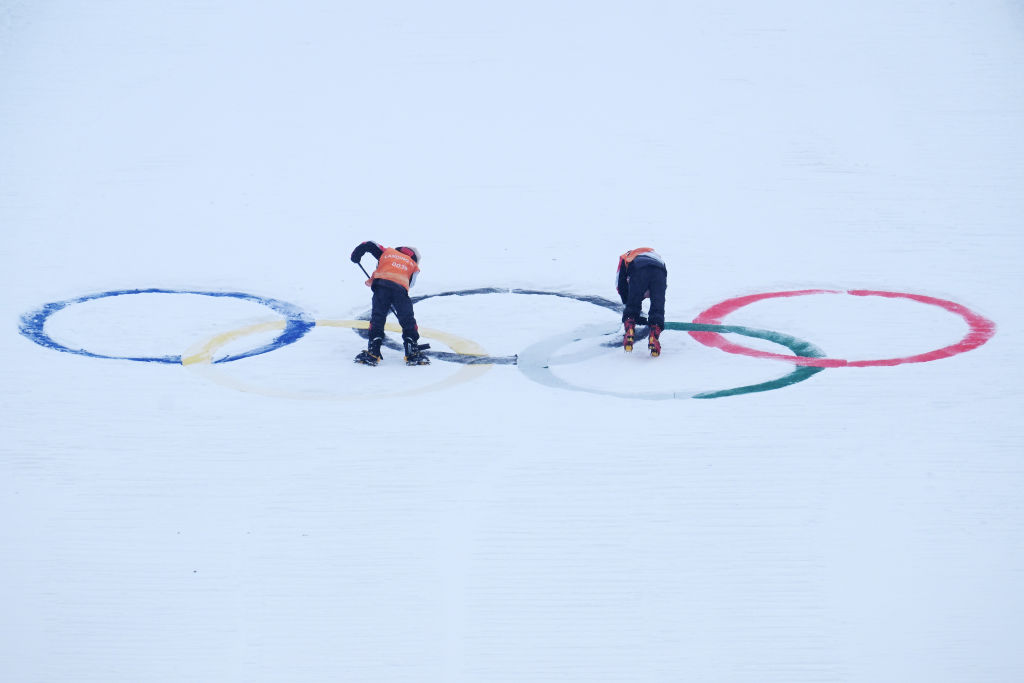Hot, Costly, and Dangerous: Climate Change and the Future of Sports Mega Events
Why this matters
Extreme weather and a changing environment are already creeping up on athletes and their fields of play. But in the short-term, sports mega events will feel the effects of rising temperatures most.
Beach volleyball players burning their feet in the sand. Marathon runners passing out from heat illnesses. Every single flake of snow – across every skiing and snowboarding event – being artificially created. Such were the excessively hot conditions at the most recent Summer and Winter Olympics, held in Tokyo and Beijing, respectively.
They were not unlucky coincidences.
Human activity is adding heat-trapping greenhouse gases to the earth’s atmosphere at unprecedented rates, causing the planet to warm and the climate to change in potentially catastrophic ways. From unprecedented heat waves to raging wildfires to extreme floods, the effects of this shift are already being felt. And as temperatures continue to rise and weather events become more extreme in the years and decades to come, the effects of this shift will increasingly be felt at sports mega events such as the Olympics and the World Cup, too.
Athletes, organizers, and fans will be forced to cope with hotter, costlier, and more dangerous conditions. Governments and urban planners will have to factor climate change into legacy planning – that is, what becomes of the structures and facilities created for sports mega events after those events are over.
Meanwhile, the events themselves will need to reckon with their own environmental impact, because while sports are affected by climate change, they also actively contribute to it.
Future Risks To Mega Events
Last year, my colleague Dr. Madeleine Orr of the University of Loughborough London and I published a study predicting the impact of climate change on the Olympics and the Men’s World Cup over the next decade. Using historical climate data and recent United Nations reports on climate change, we made climate projections for each known future host city for both events. Next, we compared those projections to acceptable conditions for sports.
Across all of the cities and events, we saw common – and frightening – trends. The Summer and Winter Games in Paris (2024), Milan-Cortina (2026), and Los Angeles (2028) are likely to have heat conditions unsuitable for competition and air quality that’s poor as well. So are the World Cups in Qatar (this November and December) and the multinational North American bid (2026). Only the 2032 Olympics in Brisbane are on track to be free of climate concerns; however, they are so far into the future that it’s highly possible conditions may change.
When heat is involved, two risks are paramount: summer sporting events where temperatures are too hot for athletes to compete and fans to watch safely, and winter events where temperatures are too warm for snow. Already, this year’s World Cup in Qatar will be held in the Northern Hemisphere’s winter – a historical first – in order to mitigate extreme heat. As mentioned above, the Beijing Winter Games took place almost entirely on artificial snow. It’s possible that in the future, such drastic-seeming measures will be the norm.
Air quality is another concern, and it can actually exacerbate climate change by trapping heat and damaging Earth’s natural layer of protection: ozone. Poor air quality is the result of small particles of toxic substances hanging in the air. Athletes breathe in more air than spectators and may be exposing themselves to harmful substances that could hinder their performance. Before the 2008 Olympic Games, Beijing enacted several restrictions on driving and factory production in an effort to improve their air quality.
Then there’s the matter of legacy. When host nations and communities such as Brazil (approximately $15 billion for the 2014 Men’s World Cup) and Tokyo (approximately $28 billion for the 2020 Summer Games) spend lavishly on organizing and building infrastructure for sports mega events, they are not just looking to put on a quality show. They want to create long-term, tangible benefits in the form of increased outside investment (tourism and business), better infrastructure for residents, more sports opportunities for the same, and opportunities to host more events in the future.
Climate change threatens these legacies. A 2019 study projected that in a low-emissions future – that is, a future in which the world gets its act together and cuts carbon output quickly and effectively – only 13 of the previous 21 Winter Olympic host communities will have reliable enough climates (read: enough cold and snow) to host the Games again. A January 2022 study updated this outlook based on a high-emissions future and found that number drops to one community, Sapporo, Japan.
Or consider Brazil. If sea levels rise sufficiently, Rio de Janeiro’s Olympic golf course might end up underwater. All of the money that went into the course – as well as any chance of residents enjoying it – would be washed away.
Speaking of money, climate change will likely raise the cost of staging mega events through increased frequency and strength of natural disasters, excessive heat, and reduced resources needed for hosting. In a warmer world where Beijing-style artificial snow is required to put on the Winter Games, for example, Olympics organizers will be competing with local businesses, farmers, and residents for already-scarce freshwater resources – a competition that will drive up prices.
Mega Events Impacting the Environment
Sports have a two-way relationship with the natural world. They not only are dependent upon the environment for competitive space and conditions but also impact the environment through using resources, creating pollutants, and transforming land for competitive purposes.
As mentioned above, the Beijing Games were projected to require over 49 million gallons of water to create the artificial snow needed to stage competitions. Using freshwater for this purpose – and creating snowpack in areas where it usually does not occur – may have harmed the biodiversity of the region.
Over time, sports mega events have grown in size and scope. The 1896 Olympics in Athens featured nine sports and 10 disciplines; the Tokyo Games hosted 33 sports and 50 disciplines. Similarly, the Men’s World Cup has grown from hosting 13 teams in 1930 to 32 teams in 2022. Bigger events mean bigger environmental impacts from those events: more venues, training facilities, hotels, and other facilities to build; more people traveling to host sites via airplanes and automobiles; more resources being used; and more carbon being emitted.
This isn’t a new problem. In the 1970s, voters in Denver, Colorado, rejected funding a winning bid for the 1976 Winter Olympics partly out of concern for the environmental harm the event might produce. In 1992, environmental destruction caused by the Winter Olympic Games in Albertville, France, sparked changes in environmental policy from the International Olympic Committee.
Since 1994, all Olympic bids have been required to address climate conditions as well as environmental harms. Since the bidding process encourages one-upmanship by host candidates, these environmental plans have become increasingly robust with time: In the 1990s, bids included only harm reduction measures, and now bids promise carbon neutrality.
That’s the good news. The bad news is that Olympic bids are non-binding promises made by the local organizing committees that end up managing the actual events – and there are no guarantees that those committees will live up to their environmental promises. Moreover, the IOC has no real mechanism to reprimand or punish Olympic hosts that come up short; to the contrary, moving events, fining hosts, or canceling the Games altogether are all non-starters, because nobody involved wants to lose money. So when environmental pledges aren’t kept, everyone just moves on.
In addition, the true environmental impacts of mega events often are not seen until years after those events are held. Stadiums do not deteriorate into “white elephants” immediately, and climate change does not occur overnight. Meanwhile, organizing committees dissolve and disperse after the last medals and trophies have been handed out, which means no one besides each local government is obligated to ensure that any long-term environmental consequences are managed years or decades into the future.
Setting an Example?
So what can sports mega events do about climate change? Three things come to mind:
- Organizers need to plan ahead for how environmental shifts may influence events. For example, the Tokyo 2020 marathon moved to Sapporo due to concerns over heat.
- Infrastructure and practices must be adapted to mitigate potential climate vulnerabilities, such as Beijing’s use of artificial snow or Qatar’s air-conditioned outdoor stadiums for the upcoming World Cup.
- The formats of mega events need to be reconsidered in order to decrease the environmental burdens the events create.
This could involve any number of format changes counter to the current Olympic model of hosting the Games all over the world:
- Awarding bids to modest proposals that reuse existing infrastructure.
- Creating permanent host sites.
- Rearranging sports as part of the Summer or Winter programs.
- Eliminating some sports altogether.
- Even holding these mega events less often.
Climate change is a moving target. Global average temperatures – and the necessary carbon emissions reductions needed to keep them in a relatively less disruptive range – are constantly shifting. Like the rest of us, sports planners will need to be attentive and flexible in order to successfully adapt.
Their success is important. The Olympics and the World Cup are the two most visible sports events in the world, two of the most destructive to the environment, and two of the most affected by climate change. By becoming leaders for environmentally sound practices and climate mitigation, they can set a needed example – and perhaps secure their own futures for generations to come.
Monthly Issue
The Sustainability of Sport
Sport is a large-scale global pursuit that brings together people and places, often creating deep roots with the environment in which it is played. As a result, sport both contributes to ecological change and is affected by it.
As efforts intensify to address decades of carbon emission, commercial growth, and environmental deterioration, sport can take the lead in championing progress. If current trends continue, however, sport could face some of the more serious consequences of a changing Earth.



